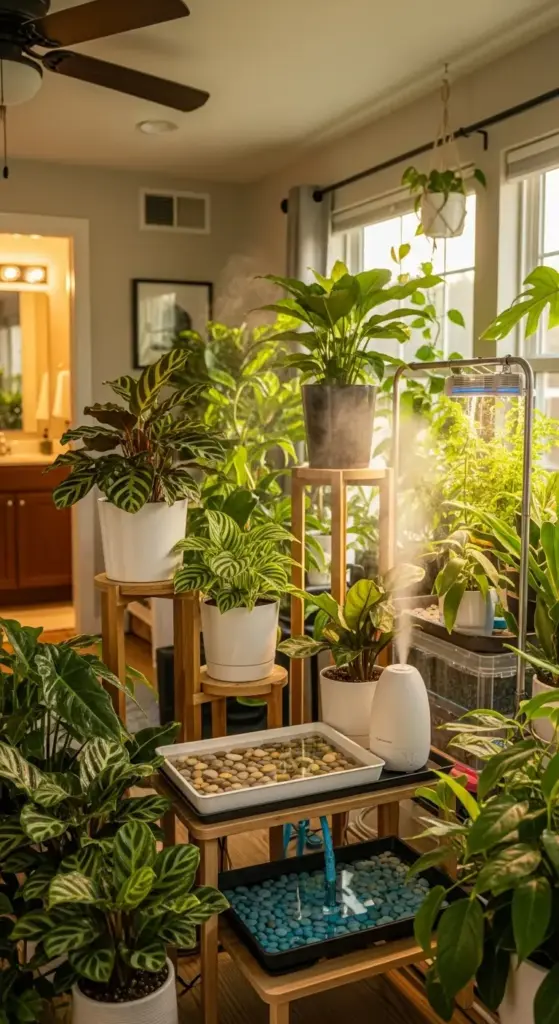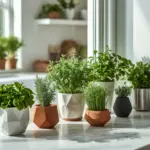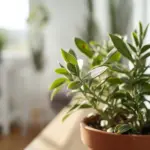7. Create the Ideal Growing Environment

Creating the perfect plant environment felt impossible at first. I thought I needed a greenhouse or some fancy setup to make my plants truly happy.
Turns out, a few simple tweaks to your home environment can transform struggling plants into absolute showstoppers.
Humidity Control for Different Plant Types
Tropical plants are basically humidity addicts. My calathea looked sad and crispy until I figured out it needed way more moisture in the air.
Pebble trays are the easiest humidity hack ever. Fill a shallow tray with pebbles, add water, and set your plant on top. Instant humidity boost!
Grouping plants together creates a natural humidity bubble. They release moisture through their leaves and share it with their neighbors.
I bought a cheap humidifier from Target and it changed everything. My tropical plants went from surviving to absolutely thriving within weeks.
Misting is controversial – some plants love it, others hate it. Ferns and air plants love a good misting, but fuzzy-leaved plants can get fungal problems.
Bathroom plants get natural humidity from showers. My Boston fern lives in my bathroom and has never been happier.
Desert plants actually prefer low humidity. My succulents started doing better when I moved them away from my humidifier!
Humidity meters help you track levels. Most tropical houseplants want 40-60% humidity, which is higher than most homes naturally have.
Temperature Management Throughout Seasons
Most houseplants are happiest between 65-75°F during the day. Night temperatures can drop 5-10 degrees without problems.
Avoid temperature extremes like heating vents and drafty windows. I killed a beautiful croton by putting it next to a heat register.
Cold drafts are plant killers in winter. That spot by the front door might seem bright, but the cold air will stress your plants.
Seasonal temperature changes are natural and actually beneficial for many plants. My Christmas cactus needs cool nights to bloom properly.
Space heaters can create hot, dry microclimates that stress plants. I learned this when my plants closest to the heater started dropping leaves.
Air conditioning can also be problematic. The cold, dry air made my tropical plants unhappy until I moved them away from direct AC flow.
Temperature consistency matters more than hitting exact numbers. Wild swings stress plants more than being a few degrees off ideal.
Air Circulation Importance and Solutions
Stagnant air is a recipe for fungal problems and pest infestations. Plants need gentle air movement just like they’d get outdoors.
Ceiling fans on low speed work perfectly. Just enough movement to keep air fresh without creating harsh drafts.
Small desk fans can help in rooms without ceiling fans. I point mine at the wall so it creates gentle, indirect air circulation.
Opening windows when weather permits gives plants fresh air and natural breezes. My plants always perk up after a day with windows open.
Overcrowded plants can’t get proper air circulation. I had to spread out my collection after dealing with recurring fungal issues.
Bathroom exhaust fans help prevent excess humidity buildup that can lead to mold and mildew problems.
HVAC systems provide some air circulation, but it’s often too direct and harsh for sensitive plants.
Grouping Plants for Mutual Benefit
Plants with similar needs do better when grouped together. My tropical corner has consistent humidity and care requirements.
Tall plants can provide shade for smaller, more delicate plants. My rubber tree protects my prayer plant from harsh afternoon sun.
Humidity-loving plants create their own microclimate when grouped. It’s like they’re helping each other stay comfortable!
Different heights create visual interest and maximize space. I use plant stands to create layers in my plant groupings.
Companion planting works indoors too. Some plants naturally repel pests that bother their neighbors.
I avoid mixing high-water plants with drought-tolerant ones. Makes care routines much easier when plants have similar needs.
Seasonal groupings help with care adjustments. I move all my tropical plants closer together in winter for easier humidity management.
Seasonal Care Adjustments
Winter care is completely different from summer care. Less water, no fertilizer, more humidity – basically the opposite of growing season.
Shorter days mean plants need less water and nutrients. I cut back watering frequency by about half in winter months.
Heating systems dry out the air dramatically. I run humidifiers constantly from November through March.
Spring awakening is exciting but gradual. I slowly increase watering and start fertilizing again as days get longer.
Summer growth spurts require more frequent watering and regular feeding. This is when plants put on most of their growth.
Fall preparation means tapering off fertilizer and reducing watering frequency as plants prepare for dormancy.
I move plants seasonally based on changing light conditions. That bright summer spot might be too dim in winter.
Long-term Plant Health Maintenance
Annual repotting keeps most plants healthy and growing. Spring is the best time when plants are ready to grow into fresh soil.
Regular pruning maintains plant shape and removes dead or diseased material. I do light pruning year-round as needed.
Rotating plant collections prevents any one area from getting depleted nutrients or developing pest problems.
Deep cleaning leaves monthly helps plants photosynthesize better. I use a damp cloth or gentle shower spray.
Monitoring for changes in growth patterns, leaf color, or overall health helps catch problems early.
Keeping detailed records of care routines, problems, and solutions helps you learn what works for each plant.
Long-term success comes from consistency and patience. Plants reward steady, appropriate care with years of beauty and growth.
Seasonal deep cleaning of pots, saucers, and plant areas prevents pest and disease buildup over time.
I’ve learned that creating the ideal environment isn’t about perfection – it’s about understanding what your plants need and making small adjustments over time.
The most successful plant parents aren’t the ones with perfect setups, but the ones who pay attention and adapt their care as they learn what works!
Conclusion
Growing thriving small plants isn’t about having a magical green thumb – it’s about following these seven critical steps consistently! From choosing the right plant for your lifestyle to creating the perfect growing environment, each step builds on the last to ensure your plant babies flourish.
Remember, every plant parent started somewhere, and mistakes are part of the journey. The key is learning from them and applying these proven strategies. Your future self (and your plants) will thank you for taking the time to do it right from the start.
Ready to transform your space into a lush, Instagram-worthy plant paradise? Start with step one today, and watch as your confidence and your plant collection grow together. Happy planting!









GIPHY App Key not set. Please check settings